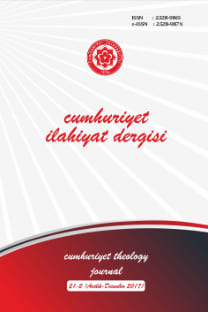Vakf ve İbtida İlmi ve Kur'an Tefsirindeki Yeri
Kur'an ilimleri Içerisinde önemli bir yere sahip olan Vakf ve İbtida İlml, Kıraat İlmi için olduğu kadar Kur'an tefsiri için de önemlidir. Mananın tamam olduğu duraklarda okumayı kesip nefes almak olan "vakf' ile mana bütünlüğüne uygun düşen yerlerden başlayarak okumayı sürdürmeyi Ifade eden "lbtlda",. Kur'an'ın tefsiri, maksat ve manalarının ortaya çıkarılmasına da büyük katkı sağlamaktadır. . Mütaahhlrinden bazı alimler, Sünnet olduğu gerekÇesiyle vakf yapmak için fasılaları (ayet sonlarını) tercih yoluna gitmişler ise de alimierin çoğunluğu maı:ıanın ve anlatı rnın tamamlandığı yerleri daha uygun bulmuşlar; uygulamada bu görüş ağıriık kazanmıştır. Vakf ve lbtida çeşitleri de mana esasına dayalı olarak, anlam bütünlüğünün oluşmasındaki derecesine göre genelin kabulünü kazanan tertlple tam vakf, kafi vakf, hasen vakf ve -anlam bütünlüğü oluşturamaması hasebiyle yapılması uygun bulunmayan- kabih vakf şeklinde sıralanmıştır. Konu etrafında geliştirilen diğer termlnolojinln de anlam bütünlüğü üzerine bina edildiği görülecektir. Sözlü anlatım ve öğretim yöntemiyle aktarılan bu bilgiler hlcri üçüncü asrın hemen başlarında kitapiaşma, müdevven ilim olma aşamasına geçmiştir. Bu süreç devam ederken hicri dördüncü asırda yeni bir süreç başlamış, vakf çeşitleri işaretlerle, sembol harflerle gösterilmiş ve bunlar mushaflarda ilgili kelimenin üzerine konularak bizzat kullanılmıştır. Bu çalışmalar arasından Secavendi (560/1164)'nin geliştirdiği vakf sistemi, terminoloji ve işaretler revaç bulmuş; sonradan geliştirilen terminoloji de onun üzerine bina edilerek yaygınlık ve süreklilik kazanmıştır. Bugün İslam aleminin hemen tümünde basılmış olan mushaflarda kullanılan vakf sistemi bu sistemdir. Vakf ve İbtida İl ml, Kur'an tefsirinde sahlh ltikadın belirlenmesi; hükümlerin sağlam bir biçimde tespiti; doğru mananın ortaya konulması; sağlıklı haberin açığa çıkarılması; bilgilerin doğru olan kaynağa kanalize edilmesi; vb. bir çok açıdan lnkarı kabil olmayan bir role sahiptir.
Vakf ve İbtida İlmi ve Kur'an Tefsirindeki Yeri
The Science of Waqf and Ibtida is one of the Qoranic Sciences and ,it's important for the commentary and reeltatian of the Qoran. This ccience stems from the Qoran itself since the "tartil" which is mentioned therein means "reading it without hurry, clearly, word by word, letter by letter ... showing pauses and beginnings". "Waqf" means "pausing during reeltatian when one is in need of breath" and "ibtida" means "starting recitation by beginning samewhere is suitable after breath". Both of waqf and ibtida have to suit perfect meaning of the Qoranic verse and ought to be made in samewhere suitabie. The main rule in waqf and ibtlda is that the meaning has to be perfect, true, and complete. However same of the later scientlsts accepted the ends of Qoranic verses (fasila) for waqf as indicated in a prophetic tradition/practice. But this ls not practlcal. A number of scientists accepted the first principle as a rule and they classifled them in relation to the meaning: the. perfect (al-tamm), the .enough (al-kafi), the well (alhasan) and the ugiy (aı-qabih) waqfs. The latter is forbidden to be ·made because of the meaning is not perfect and not sufflcient to be understood. The information collected aiong years about the subject were transmitted orally until the third century of the Hegira. Then at the beginning of this century this information was copied down into the books. After this period at the fourth century and later some symboHetters were invented for all kinds of the waqfs. None was well-known until ai-Sadjawandi (560/1164) who came and set his special system up and it has found acceptance nearly all over the Islamic World up to now. These symbois are used in the Holy Qorans printed now a days. This science heıps the scıence of commentary to determine the correct meaning, which is vitai for a sciund belief.
